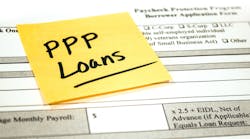Many of you have received Payroll Protection Program (PPP) funds from the Small Business Administration. If you haven’t, the second round will hopefully be your opportunity. There is still a tremendous amount unknown about this grant, particularly about how forgiveness will work. New details and questions emerge almost every day.
Meanwhile, there are things you can do to help well-position your company for loan forgiveness. I make no guarantees that these will work or be required, but they are what many lawyers are recommending, and many manufacturers are currently doing. I appreciate that some of this advice might be overkill, but sometimes better safe than sorry:
1. The covered period of potential forgiveness begins on the day you get your money and lasts for eight weeks. Here, you have options on how to proceed.
You could hire everyone back immediately upon receiving your money (if they aren’t already working, of course). This would maximize your loan forgiveness, assuming that you had the same or more full-time equivalent employees as the same time in the previous year (or January 1 through February 15 of 2020, at your discretion).
But, based on business conditions, maybe you won’t hire everyone back, and then you will have to manage the 75/25 split of payroll vs. other expenses. Subject to further SBA guidance and interpretation, during the eight-week period, non-payroll expenses cannot exceed 25% of the total amount of PPP-paid expenses.
To be clear, this rule is very confusing. There is debate (and contradiction in the rules) around whether this 75% applies to what is actually paid during the eight weeks, or just what is given in the loan.
To be conservative, if you don’t hire anyone back, you may not be able to benefit from forgiveness of the payment of mortgage, utilities, rent, etc. However, it appears you may be able to ignore this rule if you hire everyone back before June 30, 2020, even if you didn’t hire them back during the eight-week period. Obviously, you won’t get loan forgiveness for the payroll costs not paid during that eight-week period, but you potentially will get your mortgage, utilities, and rent paid for. We will update you as the SBA issues its future guidance on these issues.
There is extra complication in bringing your employees back for the eight weeks because you likely don’t want to hire them back and the let them go again, and some of them are making more money on unemployment. You will need to consider this when you are ramping back up, at least until July 25, when the extra federal incentive ends for everyone on unemployment.
2. Establish separate ledger accounts for expenses to track that you are using PPP dollars for the allowable payroll (up to a pro-rated $100k cash compensation per employee), mortgage interest, rent, benefits, and utilities. Allowable payroll costs include the full amount of retirement benefits, healthcare benefits paid by the employer, and employer state and local (but not federal) payroll taxes.
3. Some lawyers recommend separating paychecks for those employees who make over $100K so that they get their over-$100K portion of their salary separate from the under-$100K portion—again, so that it is tracked easily. Discuss this further with your payroll service provider.
4. Save all documentation regarding how the funds are expended including invoices, cancelled checks, payment receipts, payroll reports, transcripts of accounts, etc.
5. There is a line in the bill that references that eligible forgiveness will come from “costs incurred and payment made during the covered period payroll costs.” This presents a problem that may be fixed through further clarifications, but prepayments probably would not be allowed and neither would paying your bills after the period. Prior to new SBA guidance being issued, this would mean that you will want to cut your last payroll checks, get your bills in and pay them all on the last day of the eight weeks to maximize forgiveness.
Ethan Karp is president & CEO, MAGNET (the Manufacturing and Growth Network), an Ohio Manufacturing Extension Partnership.




